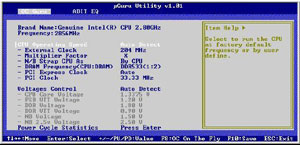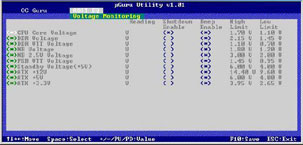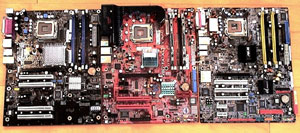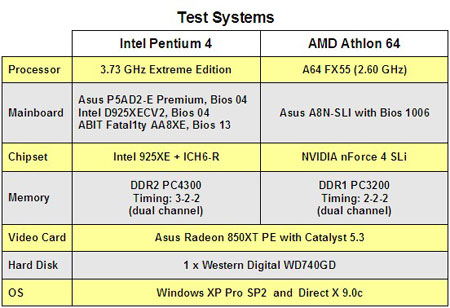|
|
|
|
|
ABIT Fatal1ty AA8XE i925XE LGA775 Motherboard |
|
Join the community - in the OCAU Forums!
|
BIOS, uGuru, Testbed and Test Methodology
AA8XE FEATURES VS ASUS P5AD2-E PREMIUM:
ABIT’s Fatal1ty AA8XE is competing with the ASUS P5AD2-E Premium. These 2 boards are currently regarded as the best performing 925XE platforms. In terms of features the ASUS board offers quite a bit more: Wireless LAN, 2-port IDE ATA RAID, 4-port SATA RAID and next generation IEEE 1394b (FireWire 800) with bandwidth up to 800 Mbps.
Wireless LAN is nice to have but can be, if necessary, provided by an add-on card. The additional 4-port SATA controller implemented on the P5AD2-E looks like overkill to us. The ICH6-R on both boards already offers 4-port SATA RAID. And being native SATA, the ICH6-R is a much more efficient solution than the PCI based SATA RAID controller from “Silicon Image”. IEEE 1394b is good in principle. It’s aiming at digital video cameras, but we are not aware of any device supporting this standard yet.
The remaining advantage of the P5AD2-E is that it comes with the additional ATA IDE RAID controller with 2 ATA IDE channels, whereas the AA8XE has only one such channel. Although the change to SATA is in full swing and even optical drives are now available with the SATA interface, most users still require more than just one ATA IDE channel. The 3rd board in our test, Intel’s 925XE reference board, by the way, also offers only 1 ATA IDE channel. The other issue we have with the AA8XE is – don’t laugh - its color. Beauty lies in the eye of the beholder, and our eyes don’t see much beauty here. The combination of a reddish PCB with pastel green heat sinks is – “yak”! The black Intel and ASUS PCB, a color previously also used by ABIT for their MAX series looks much better - in the eyes of most beholders.
BIOS AND “uGuru” MONITORING AND OVERCLOCKING UTILITY:
The AA8XE comes with the well-known “Phoenix Award” BIOS. It offers the usual settings for basic board operations, such as PCI configuration, integrated peripherals, SATA functions. The ICH6-R based SATA RAID has it own BIOS that pops up during the boot process. In order to make it accessible the SATA RAID function has to be enabled in the main BIOS. This is very much the same procedure for all boards with Intel’s ICH5-R and ICH6-R. The “Advanced Chipset Features” section contains the settings for the all important memory timings. Tweaking them can provide an additional performance boost of up to 8% as we have recently shown in our review of high-performance DDR2 memory. The “Advanced Chipset Features” section contains also settings for the PCI Express bus and the ABIT “Game Accelerator”. The later allows running the AA8XE with more aggressive system timings and should be usually kept enabled, unless for extreme overclocking.
 
The most exciting part of the BIOS is in the “uGuru” section. The functions available there are provided by ABIT’s propriety health and monitoring chip implemented on many newer ABIT mainboards. It allows monitoring and controlling various system functions through a monitoring utility called “ABIT EQ” and an overclocking utility called “OC Guru”.
 
“ABIT EQ” allows setting system alarms, regulating the speed of CPU, Northbridge and OTES fans, and shutting down the system in response to selectable temperature thresholds. These functions are particularly useful when the system is running unattended for a long period of time, for example for distributed computing projects. “OC Guru” provides the torture instruments for overclocking: External clock (FSB) frequency up to 400 MHz, multiplier factor, CPU to RAM ratios, as well as PCI and PCI Express frequencies. “OC Guru” allows furthermore manipulating 6 different system voltages: The all important CPU voltage can be set as high as 1.925 volt, and the not less important memory voltage as high as 2.55 volt. All “uGuru” functions are conveniently available from within Windows as well. Unlike other manufactures that base such utilities on standardized health monitoring chips, mainly from “Winbond”, ABIT has taken more pain by developing their own hardware solution. And it pays off: The “uGuru” propriety chip provides more tweaking and monitoring possibilities than any other such utility in the market.
TESTBED AND TEST METHODOLOGY:
We are benchmarking the AA8XE against 2 other chipset 925XE based boards. The D925XECV2 is Intel’s own mainboard based on their 925XE chipset. It’s one of the few Intel boards that offer limited overclocking capability. We have tested the board a while ago with good results. The 3rd 925XE based mainboard in our test is the already mentioned ASUS P5AD2-E Premium. Users are reporting excellent results and overclocking headroom with this product. It is widely regarded as the AA8XE chief rival. The 925XE chipset allows running the processor with an external frequency (FSB) of 1066 MHz. We were testing these 3 mainboards with the just released Prescott (6xx series) core based 3.73 GHz Extreme Edition – currently Intel’s’ most powerful desktop processor.

ABIT is aiming with the Fatal1ty AA8XE at gaming enthusiasts. When the AA8XE was launched, ABIT did actually claim the AA8XE to be the fastest product for this purpose. This apparently cannot be true anymore as the nForce 4 SLi chipset, unlike the 925XE chipset, allows gaming with 2 video cards running in parallel. It delivers 3D performance that cannot be matched by a system running with a single video card. The nForce 4 chipset is currently only widely available for AMD processors, although the "Intel Edition" has been announced since our testing. We nonetheless included the nForce 4 based ASUS AN8 SLi running with an A64 FX55 AMD processor and a single video card in our test to see how the currently most powerful Intel and AMD platforms are competing at equal footing – even though running a SLi system with only one video card is like driving with your foot on the brake.

All systems were tested at the “best of their capabilities” with the memory running at the most aggressive timings possible. We initially intended to use the fabulous OCZ DDR2 PC4300 EB Rev 2 for all 925XE boards. Unfortunately we found that the AA8XE does not boot with this memory. We contacted OCZ and they confirmed that it is indeed not working with the AA8XE. ABIT is claiming to have solved this issue with BIOS revision 13, but this is apparently not the case, as we were using this BIOS revision on our test board. We used instead Corsair’s recently released DDR2 TwinX XMS2-4300C3 which is also capable of running at 533 MHz with timings of 3-2-2. The ASUS AN8 was running with DDR1 PC3200 at 2-2-2. All other system settings, driver versions and hardware components were kept, as much as possible, identical.
|
|
Advertisement:
All original content copyright James Rolfe.
All rights reserved. No reproduction allowed without written permission.
Interested in advertising on OCAU? Contact us for info.
|

|


